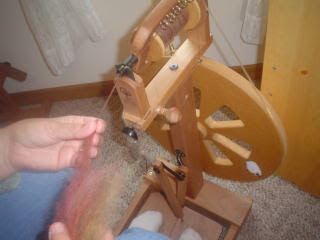
Part of the fun of having your own sheep is having nice fiber to spin. There are about 1,000 different breeds of sheep in the world today, over 200 of which are thought to be in the United States, and of which roughly 40 or so of those are common breeds (American Wool Council). To a spinner, that means fun! There are so many different types of fiber available from these sheep. I didn't realize that a sheep is not a sheep, is not a sheep myself, until I became a spinner.
So the first thing a spinner has to do is get a wheel! If you have spinner friends who might have a wheel they could loan you for a bit, that is ideal. If you can't find a situation like that, sometimes shops can loan wheels out for a couple weeks to give you time to try a brand. Some people pick a wheel they think they'd like, buy it, and start spinning. I found getting a wheel was the hardest part! Here's why:
Spinning is a very personal thing. Everyone's body is different. What might be comfortable for one person may not be comfortable for the next. There has never been a better time than right now for spinners, because there are MANY options in modern wheels out there right now. Overwhelming in fact! And all of them are so nice! In fact, after you start spinning, this becomes a problem, because you start pining for other wheels, and loving them all! :)
If you can try out a wheel without having to buy it, you can spin at it awhile and tell if your body is comfortable on it. Some people feel they really need one foot grounded so only spin on single treadles. Others like the rhythm of two treadles. Some people like saxony wheels (drive wheel beside flyer), some people like castle wheels (flyer above drive wheel). Some people love double drives, some people love scotch tension. There are many choices!
The wheel pictured above is not my first wheel, but one I use for lessons. It's an Ashford Kiwi, which is promoted as a student wheel. If you buy the simpliest package, it is a very simple, straightforward wheel. That is why it makes for a good student wheel. I like it because it is sturdy, offers the student a good view of everything going on, and because it spins very smoothly. The treadles offer you good heal control as well, making control of your flyer easier, something new students come to appreciate. Even though I bought it to give lessons, I end up using it a lot myself! It also travels extremely well as it sits sturdily on the floor of my vehicle and doesn't tip easily.
When learning to spin, what should you avoid? Well, try not to buy a wheel right away. Wait until you can try different wheels (I mean sit and spin at one for a few hours. Your body will tell you if it likes that wheel or not by either aches and pains or lack thereof.) I spun on one wheel for two weeks when I was new and loved it. Then I realized my back was hurting in strange new ways. When I made the connection to the wheel, I realized the wheel didn't fit me well, so I tried a different wheel and the new pains went away.
Also, avoid those beautiful antique wheels when you're new. As wheels age, the wood can change, causing alignment to be slightly off, just enough to prevent super smooth spinning. Drive bands can pop off, etc. These wheels are treasures, and some work beautifully, but usually they are tempermental. After you get the hang of spinning, this is less of a concern, but when you are new, it can cause frustration.
One last thing to think about. Some people like to go traveling with their wheels to guilds, classes, etc. If you think you might want to do that, be sure to shop for a wheel that makes a good traveling companion. Smaller, castle wheels travel well. Some wheels fold up. How much space do you have in your vehicle, and where would it ride? Could you seat-belt it in there, for safety? Is the wheel comfortable to carry across the festival grounds? Some spinners have a traveling wheel that isn't too expensive, just in case it gets dropped or whatever, and one beautiful wheel they keep at home. Oops! There's that pining again!
Well, hope this is helpful. Then after you start spinning, you can play around with all the different fleece types from different breeds, and tour the world! It's fun!

Current read: Alice Starmore's Book of Fair Isle Knitting, Taunton Press, 1988
I get this book from our library over and over again. Has some history of the Shetland Islands and nice pictures. I especially like the the one of HRH The Prince of Wales dated 1903 in his Fair Isle pullover (p.23) and the one on the page before it of a Shetland woman knitting (p.22) It's hard to fathom the contrasts.
No comments:
Post a Comment